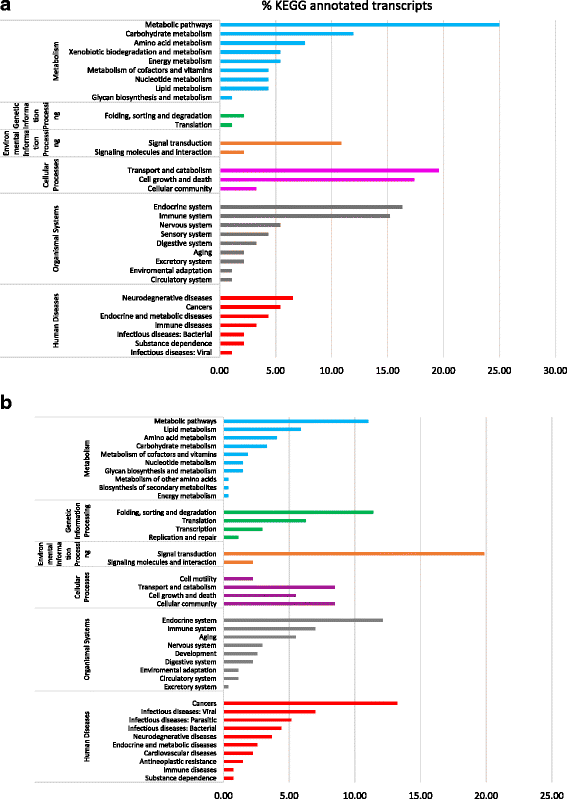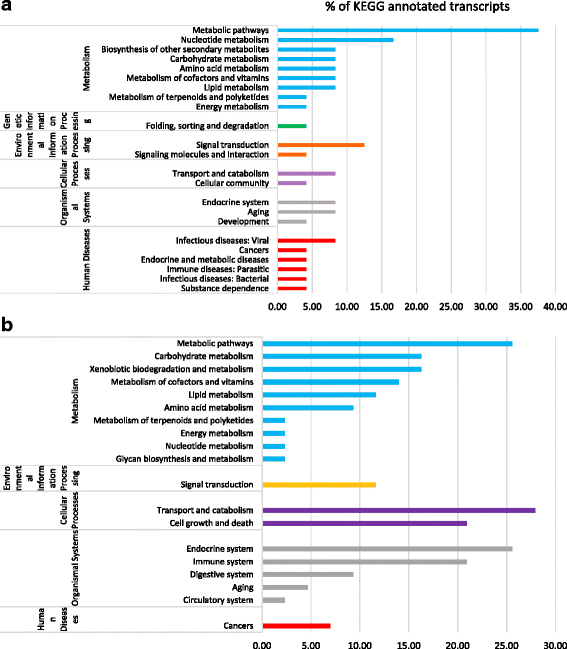Transcriptome analysis of the whitefly, Bemisia tabaci MEAM1 during feeding on tomato infected with the crinivirus, Tomato chlorosis virus, identifies a temporal shift in gene expression and differential regulation of novel orphan genes
- PMID: 28494755
- PMCID: PMC5426028
- DOI: 10.1186/s12864-017-3751-1
Transcriptome analysis of the whitefly, Bemisia tabaci MEAM1 during feeding on tomato infected with the crinivirus, Tomato chlorosis virus, identifies a temporal shift in gene expression and differential regulation of novel orphan genes
Abstract
Background: Whiteflies threaten agricultural crop production worldwide, are polyphagous in nature, and transmit hundreds of plant viruses. Little is known how whitefly gene expression is altered due to feeding on plants infected with a semipersistently transmitted virus. Tomato chlorosis virus (ToCV; genus Crinivirus, family Closteroviridae) is transmitted by the whitefly (Bemisia tabaci) in a semipersistent manner and infects several globally important agricultural and ornamental crops, including tomato.
Results: To determine changes in global gene regulation in whiteflies after feeding on tomato plants infected with a crinivirus (ToCV), comparative transcriptomic analysis was performed using RNA-Seq on whitefly (Bemisia tabaci MEAM1) populations after 24, 48, and 72 h acquisition access periods on either ToCV-infected or uninfected tomatoes. Significant differences in gene expression were detected between whiteflies fed on ToCV-infected tomato and those fed on uninfected tomato among the three feeding time periods: 447 up-regulated and 542 down-regulated at 24 h, 4 up-regulated and 7 down-regulated at 48 h, and 50 up-regulated and 160 down-regulated at 72 h. Analysis revealed differential regulation of genes associated with metabolic pathways, signal transduction, transport and catabolism, receptors, glucose transporters, α-glucosidases, and the uric acid pathway in whiteflies fed on ToCV-infected tomatoes, as well as an abundance of differentially regulated novel orphan genes. Results demonstrate for the first time, a specific and temporally regulated response by the whitefly to feeding on a host plant infected with a semipersistently transmitted virus, and advance the understanding of the whitefly vector-virus interactions that facilitate virus transmission.
Conclusion: Whitefly transmission of semipersistent viruses is believed to require specific interactions between the virus and its vector that allow binding of virus particles to factors within whitefly mouthparts. Results provide a broader understanding of the potential mechanism of crinivirus transmission by whitefly, aid in discerning genes or loci in whitefly that influence virus interactions or transmission, and subsequently facilitate development of novel, genetics-based control methods against whitefly and whitefly-transmitted viruses.
Keywords: Bemisia tabaci MEAM1 (biotype B); Crinivirus; Gene expression; Orphan genes; RNA-Seq; Semipersistent transmission; Tomato chlorosis virus; Whitefly.
Figures




Similar articles
-
Differences in gene expression in whitefly associated with CYSDV-infected and virus-free melon, and comparison with expression in whiteflies fed on ToCV- and TYLCV-infected tomato.BMC Genomics. 2019 Aug 15;20(1):654. doi: 10.1186/s12864-019-5999-0. BMC Genomics. 2019. PMID: 31416422 Free PMC article.
-
Comparative transcriptome analysis reveals networks of genes activated in the whitefly, Bemisia tabaci when fed on tomato plants infected with Tomato yellow leaf curl virus.Virology. 2018 Jan 1;513:52-64. doi: 10.1016/j.virol.2017.10.008. Epub 2017 Oct 13. Virology. 2018. PMID: 29035786
-
Natural Infection Rate of Known Tomato chlorosis virus-Susceptible Hosts and the Influence of the Host Plant on the Virus Relationship With Bemisia tabaci MEAM1.Plant Dis. 2021 May;105(5):1390-1397. doi: 10.1094/PDIS-08-20-1642-RE. Epub 2021 Apr 6. Plant Dis. 2021. PMID: 33107791
-
Integration of Omics Approaches toward Understanding Whitefly Transmission of Viruses.Adv Virus Res. 2018;102:199-223. doi: 10.1016/bs.aivir.2018.06.005. Epub 2018 Jul 26. Adv Virus Res. 2018. PMID: 30266174 Review.
-
Manipulation of Whitefly Behavior by Plant Viruses.Microorganisms. 2022 Dec 6;10(12):2410. doi: 10.3390/microorganisms10122410. Microorganisms. 2022. PMID: 36557663 Free PMC article. Review.
Cited by
-
Co-infection of TYLCV and ToCV increases cathepsin B and promotes ToCV transmission by Bemisia tabaci MED.Front Microbiol. 2023 Mar 16;14:1107038. doi: 10.3389/fmicb.2023.1107038. eCollection 2023. Front Microbiol. 2023. PMID: 37007483 Free PMC article.
-
Transcriptome analysis and comparison reveal divergence between the Mediterranean and the greenhouse whiteflies.PLoS One. 2020 Aug 25;15(8):e0237744. doi: 10.1371/journal.pone.0237744. eCollection 2020. PLoS One. 2020. PMID: 32841246 Free PMC article.
-
Development of transcriptome based web genomic resources of yellow mosaic disease in Vigna mungo.Physiol Mol Biol Plants. 2017 Oct;23(4):767-777. doi: 10.1007/s12298-017-0470-7. Epub 2017 Sep 18. Physiol Mol Biol Plants. 2017. PMID: 29158627 Free PMC article.
-
Interactions between Common Bean Viruses and Their Whitefly Vector.Viruses. 2024 Oct 2;16(10):1567. doi: 10.3390/v16101567. Viruses. 2024. PMID: 39459901 Free PMC article. Review.
-
A Review on Transcriptional Responses of Interactions between Insect Vectors and Plant Viruses.Cells. 2022 Feb 16;11(4):693. doi: 10.3390/cells11040693. Cells. 2022. PMID: 35203347 Free PMC article. Review.
References
-
- Oliviera MRV, Henneberry TJ, Anderson P. History, current status, and collaborative research projects for Bemisia tabaci. Crop Prot. 2001;20(9):709–23. doi: 10.1016/S0261-2194(01)00108-9. - DOI
-
- Abd-Rabou S, Simmons AM. Survey of Reproductive Host Plants of Bemisia tabaci (Hemiptera: Aleyrodidae) in Egypt. Including New Host Records. Entomol News. 2010;121(5):456–65. doi: 10.3157/021.121.0507. - DOI
-
- Navas-Castillo J, Fiallo-Olive E, Sanchez-Campos S. Emerging virus diseases transmitted by whiteflies. Annu Rev Plant Physiol Plant Mol Biol. 2011;49:219–48. - PubMed
-
- Brown JK, Frohlich DR, Rosell RC. The sweet potato or silverleaf whiteflies: Biotypes of Bemisia tabaci or a species complex? Annu Rev Entomol. 1995;40:511–34. doi: 10.1146/annurev.en.40.010195.002455. - DOI
-
- Bedford ID, Briddon RW, Brown JK, Rosell RC, Markham PG. Geminivirus transmission and biological characterisation of Bemisia tabaci (Gennadius) biotypes from different geographic regions. Ann Appl Biol. 1994;125(2):311–25. doi: 10.1111/j.1744-7348.1994.tb04972.x. - DOI
MeSH terms
Supplementary concepts
LinkOut - more resources
Full Text Sources
Other Literature Sources

